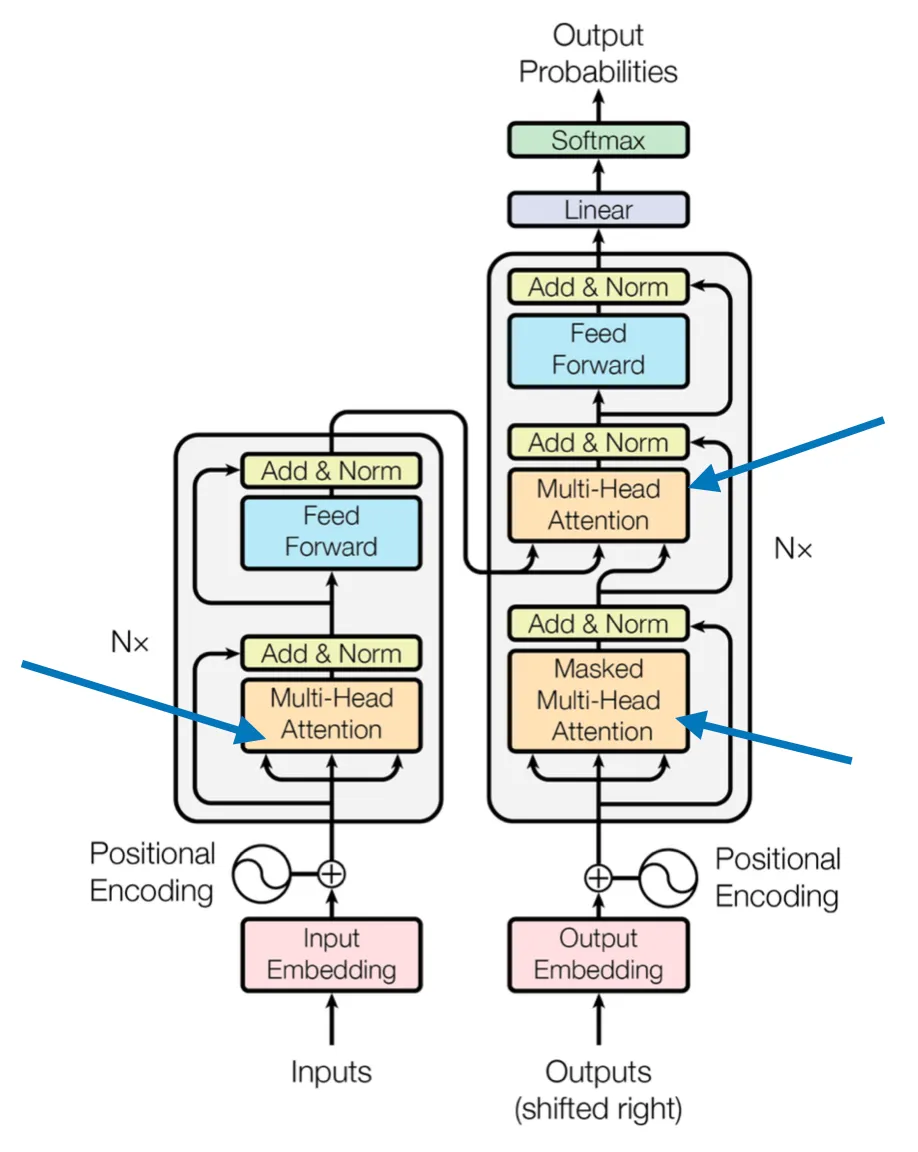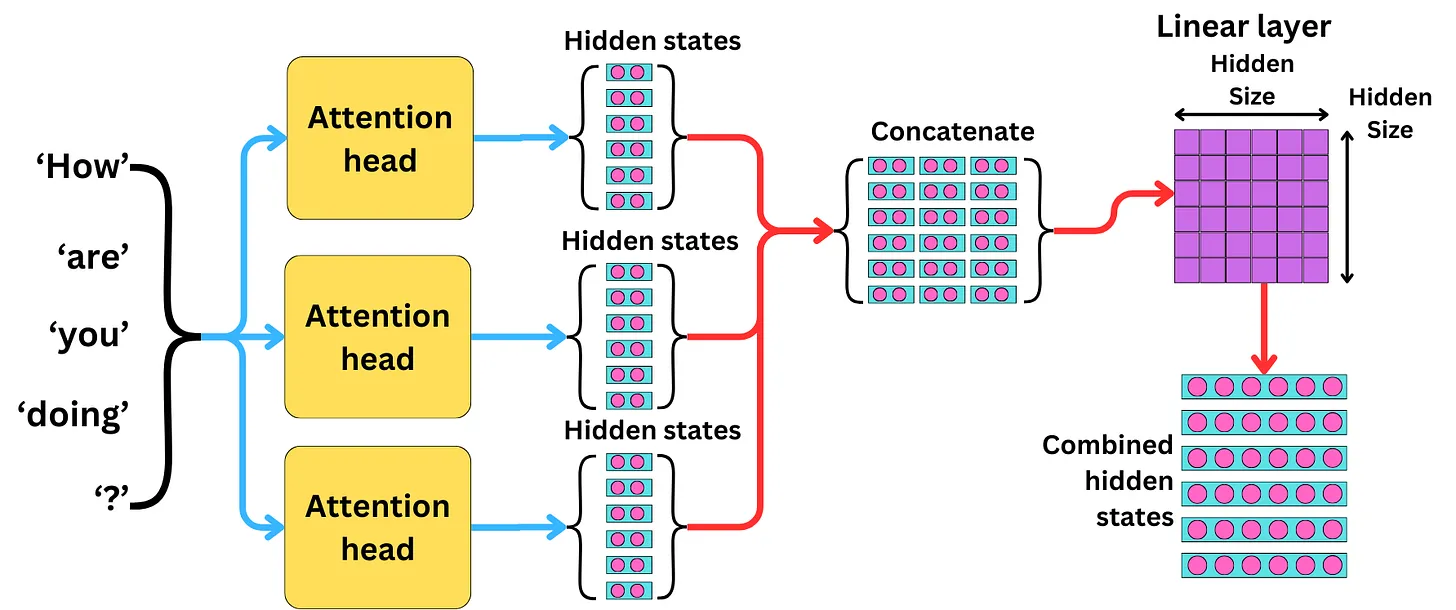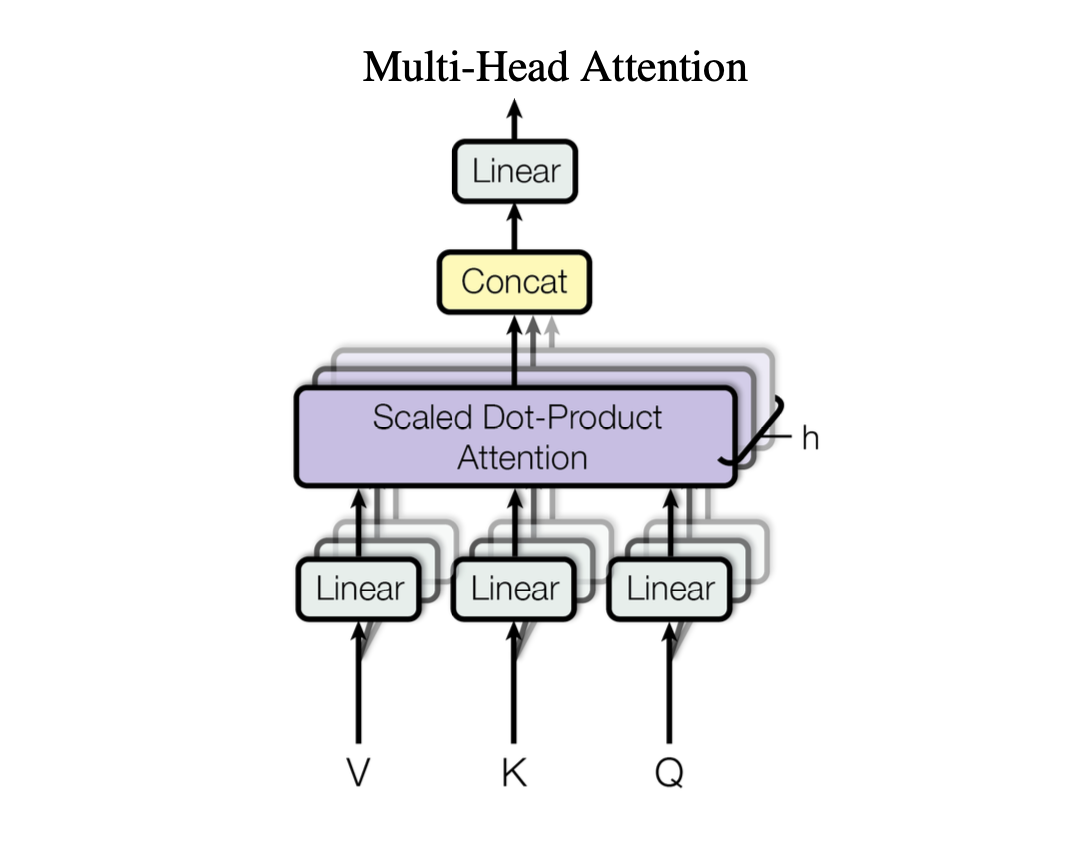Multi-Head Attention: Motivação
- Expressividade: Cada cabeça de atenção pode focar em padrões diferentes (ex.: sintaxe, semântica, dependências a longo prazo).
- Robustez: Diversificação de representações reduz risco de over‑fitting a um único padrão.
- Parallelismo: Cabeças independentes podem ser computadas simultaneamente em GPUs/TPUs.

Blocos de Multi-Head Attention no transformer original.
Fonte: https://arxiv.org/abs/1706.03762.
Multi-Head Attention (MHA)
Semelhante ao uso de múltiplos kernels em CNNs para gerar diferentes feature maps.

Multi-Head Attention. Fonte: The AI Edge.
Multi-Head Attention: Formulação Matemática
- Computar Queries:
- Computar Keys:
- Computar Values:
- Concatenar o output de todas as cabeças:
- Calcular a projeção final:

Multi-Head Attention. Fonte: Jeremy Jordan.
Implementação simples: Tokenização
import numpy as np
# Exemplos de embeddings para 4 palavras usando One-Hot Encoding
word_embeddings = {
'the': np.array([1, 0, 0]),
'cat': np.array([0, 1, 0]),
'sat': np.array([0, 0, 1]),
'on': np.array([1, 1, 0])
}
# Converte palavras em embeddings
def get_embedding(word):
return word_embeddings.get(word)
# Calcula os embeddings
sentence = ['the', 'cat', 'sat', 'on']
embeddings = np.array([get_embedding(word) for word in sentence])
print("Embeddings:\n", embeddings)
Fonte: https://kostyanuman.substack.com/p/understanding-the-attention-mechanism.
Implementação simples: Self-Attention
def softmax(x):
return np.exp(x) / np.sum(np.exp(x), axis=0)
def self_attention(embeddings):
# Calcula o produto escalar dos embeddings
scores = np.dot(embeddings, embeddings.T)
# Aplica a softmax para obter os pesos de atenção
attention_weights = softmax(scores)
# Calcula a soma ponderada dos embeddings
output = np.dot(attention_weights, embeddings)
return output, attention_weights
# Calcula a auto‑atenção
output, attention_weights = self_attention(embeddings)
print("Pesos de Atenção:\n", attention_weights)
print("Saída da Auto-Atenção:\n", output)
Fonte: https://kostyanuman.substack.com/p/understanding-the-attention-mechanism.
Implementação simples: Multi-Head Attention
def multi_head_attention(embeddings, num_heads=2):
head_outputs = []
for _ in range(num_heads):
output, _ = self_attention(embeddings)
head_outputs.append(output)
# Concatena as saídas de todas as cabeças
return np.concatenate(head_outputs)
# Calcula a atenção multi‑cabeça
multi_head_output = multi_head_attention(embeddings)
print("Saída da Atenção Multi-Cabeça:\n", multi_head_output)
Fonte: https://kostyanuman.substack.com/p/understanding-the-attention-mechanism.
Implementação simples: Saída do Bloco de MHA
def feedforward_network(x):
# Rede feed‑forward simples com uma camada oculta
# Pesos da camada oculta
W1 = np.random.rand(x.shape[1], x.shape[1] * 2)
# Viéses da camada oculta
b1 = np.random.rand(x.shape[1] * 2)
# Pesos da camada de saída
W2 = np.random.rand(x.shape[1] * 2, x.shape[1])
# Viéses da camada de saída
b2 = np.random.rand(x.shape[1])
# Ativação ReLU
hidden_layer = np.maximum(0, np.dot(x, W1) + b1)
output_layer = np.dot(hidden_layer, W2) + b2
return output_layer
# Passa as features de MHA pela rede (FC)
final_output = feedforward_network(multi_head_output)
print("Saída Final:\n", final_output)
Fonte: https://kostyanuman.substack.com/p/understanding-the-attention-mechanism.
Resumo e Próximos Passos
- Multi‑Head Attention (MHA)
- Peça-chave na capacidade dos Transformers de capturar relações entre palavras de forma eficiente e paralela.
- Projeções para Q, K, V em
- Cada cabeça calcula atenção independentemente.
- Resultados concatenados → projeção final
- As múltiplas cabeças ampliam a expressividade do modelo, permitindo diferentes focos simultâneos.
- Atenção Causal (Masked): Máscara triangular inferior impede acesso a tokens futuros.
- Interpretação Visual: Heat‑maps para comparação entre cabeças locais vs globais.

Multi-Head Attention. Fonte: Jeremy Jordan.
Perguntas e Discussão
- Qual a motivação por trás do fator
- Como o Multi‑Head Attention aumenta a capacidade expressiva de um modelo comparado ao Self-Attention? Quais tipos de dependências cada cabeça tende a capturar?
- Como a atenção pode ser interpretada como um mecanismo de explicabilidade em LLMs?
- Em cenários de poucos dados, como a atenção pode ser ajustada para evitar overfitting? Discuta estratégias de regularização.
- Qual o papel da MHA na transferência de conhecimento entre tarefas em um LLM pré‑treinado?
- Quando reduzir o número de cabeças pode ser benéfico?